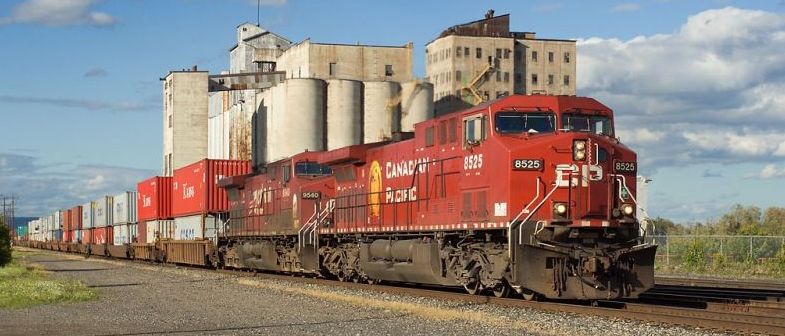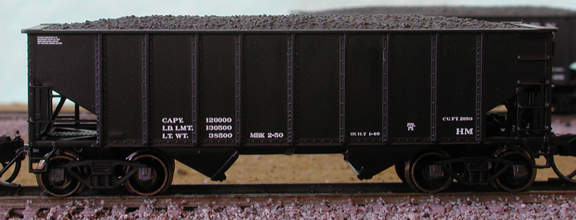
Train Addiction Help Line: 1.866.840.7777
Bluford Shops - N Scale - 8-Panel 2-Bay Hopper - Southern Pacific (SP) #SP 464599 - Post-1974 - Red With White Lettering (SKU 188-65317)
Available On: January 1, 2022


A majority of 8-panel hoppers were the result of the rebuilding of other styles of 2-bay hoppers. Offset side hoppers were particularly good candidates for this conversion. The argument for the offset side car is that by placing the side sheets on the outside of the ribs, you could then fill the volume between the ribs with coal (or other commodity.) The downside was that the offset side cars were more difficult to build and repair. Also, the load often packed in the corners between the rib and side sheets, trapping moisture and making repairs more frequent. Rebuilding them with 8 full length panels and 9 posts was relative easy and cheap, more than making up for the loss in cubic capacity. The rebuilt car could provide another 15 to 25 years of revenue service. These ready-to-run cars feature die cast slope sheet-hopper bay-center sill assembly; injection molded plastic sides, ends, and hopper doors; fully molded brake tank, valve and air lines; body mounted brake hose detail; load; body mounted magnetically operating knuckle couplers; close coupling; and Fox Valley Models metal wheels.

In the 1960s, Baltimore & Ohio sent many of their offset side hoppers over to the Raceland Shops of their sister road C&O for rebuilding into 8-panel hoppers. The cars presented in this run reflect how they appeared in their as-rebuilt paint scheme with the post-1974 addition of ACI tags and two box format consolidated stencils. They will be available in 6 road numbers.

Atlantic Coast Line’s response to the aging 2-bay hopper issue was to sell the cars to Berwick Forge & Fabricating who would then rebuild them into 8-panel hoppers and sell them back to ACL. Atlantic Coast Line moved more minerals, sand and gravel than coal so we are including “mineral” loads for this run. They will be available in 6 road numbers.

This group of Chesapeake & Ohio 8-panel hoppers was the product of a mid-60s rebuild program at C&O’s Raceland Shops. A portion of the fleet later received four yellow ribs on each side denoting that they were assigned to Armco Steel (the yellow circle next to the road number was a signal to carmen and agents that this car was for unit train service and should not be confiscated.) Changing traffic patterns and car availability rendered these markings superfluous and these hoppers scattered across the region. This paint scheme will be available in 6 road numbers.

Conrail inherited most of their 8-panel hoppers from Penn Central who had inherited them from New York Central. On Conrail’s startup day, April 1, 1976, it had been 8 years since the rebuild so they still had some life in them although not enough to warrant a full repaint job. As they ran through the car shops for routine repairs, the old road numbers were patched out and new Conrail numbers applied. This paint scheme will be available in 4 road numbers.

This Delaware Lackawanna & Western paint scheme was applied to the road’s 8-panel hoppers beginning in 1955 by their Keyser Valley Shops. The distinctive LACKAWANNA lettering comes from each letter fitting snuggly into a 24” square except for the C (which would if it were an O) and the W which is wider by exactly one line-width. This large lettering pushed the reporting marks and road number to the center of the car. In addition to moving anthracite, these cars could be found hauling New Jersey bog iron which can be modeled by painting your anthracite load (included) a dark, reddish tinged brown. This paint scheme will be available in 6 road numbers.

International Minerals & Chemicals purchased their fleet of 8-panel hoppers secondhand, probably from one of the Chessie roads. They were used to haul phosphate based minerals from mines to processing facilities primarily for the production of fertilizer. Some of these minerals could also be used to inhibit corrosion in steel. These car will have appropriate “phosphate” loads and will be available in 4 road numbers.

Louisville & Nashville’s huge South Louisville Shops turned out more than 10,000 rebuilt 8-panel hoppers during the 1960s using old offset side hoppers, PS-3’s, the last of the war emergency composite hopper fleet and carloads of new parts from Pullman Standard. This particular group emerged from the shops in 1965. Boxcar red, including the trucks was the standard for hoppers on the L&N at the time. This paint scheme will be available in 6 road numbers.

In the mid-60s, New York Central’s massive Despatch Shops greatly increased the pace of rebuilding 2-bay hoppers into thousands of new 8-panel cars. During this period, NYC preferred to place the reporting marks and road number toward the right end of the hopper side, a practice often (but not always) used on NYC boxcars in the same era. Despatch Shops equipped these cars with a new type of centerplate lubricator (the centerplate is the disc on the body bolster that makes contact with the truck bolster) and stenciled instructions to contact the company Chief Engineer in New York City if a truck is removed. This is the paragraph below the triangular paint shop mark and rebuild date. Although NYC adopted the cigar band logo seven years earlier, they continued to apply the old “gothic oval” logo on most hopper cars until the Penn Central merger. This paint scheme will be available in 6 road numbers.

Peoria & Eastern was a subsidiary of New York Central running from Indianapolis to Peoria. NYC was known for its large stable of subsidiary railroads but P&E had more of a separate identity than most, maintaining it right through the Penn Central merger. P&E was the recipient of a fleet of 8-panel hoppers produced during Despatch Shops mid-60s rebuilding frenzy. This paint scheme will be available in 4 road numbers.

Many hoppers rebuilt by New York Central’s Despatch Shops were given TOC reporting marks. TOC was Toledo & Ohio Central, which had been controlled by NYC since 1910. It ran southeast from Toledo, through Columbus, over the Ohio River and into the West Virginal coal fields. NYC leased the T&OC in 1922 at which point it became a “paper railroad.” It was finally merged into NYC in 1952. Since the TOC reporting marks were still assigned to New York Central, they could be used to easily identify cars that were subject to a specific equipment trust. The TOC road numbers were sprinkled through the NYC number series. Four TOC road numbers will be available.

Following the 1967 merger creating Seaboard Coast Line, SCL continued with the program introduced by Atlantic Coast Line to send worn out 2-bay hoppers to Berwick Forge & Fabricating to be rebuilt as new 8-panel hoppers. As with the ACL cars, these SCL cars will come with “mineral” loads. These cars ran into the CSX era. This paint scheme will be available in 6 road numbers.

Southern Pacific received this group of 8-panel hoppers from Greenville Car in 1970. They were primarily used for aggregates and ballast so “granite” loads will be included for this run. The construction boom in the Sun Belt kept these cars very busy. We present them here as they appeared after the standard 2-box consolidated stencils were applied. This paint scheme will be available in 6 road numbers.

Union Railroad ordered 500 of these 8-panel hoppers from Greenville Car. Unlike their rebuilt brethren, these cars had a capacity of 70 tons. This gave them the flexibility to be used for coal, coke, iron ore, limestone, and crushed slag. These models will include “coal/coke” loads. The Union serves the steel mills and related industries of the Monongahela River Valley south of Pittsburgh. At its height, it was the busiest freight railroad per mile of track in the world. This paint scheme will be available in 4 road numbers.

Chesapeake & Ohio rebuilt this group of hoppers into the H-25A Class in 1965. The Chessie System image was adopted in August of 1972 and once the new paint stencils had been distributed, H-25A hoppers received this paint scheme as they came due for repainting. Many remained in service in these colors well into the CSX era. This paint scheme will be available in 6 road numbers.

We will be doing a new run of Data Only 8-panel hoppers. These are perfect if you have your own freelance railroad. Just add your logo and road number and you are ready to go. The data includes: Capacity, Load Limit, Light Weight, AAR HM code, reweigh date, cubic footage, built date, trust statement and lubrication stencil.
We will also be making a limited supply of Undecorated 8-panel hoppers. These cars will be fully assembled but without paint or lettering of any kind. Please note that we do not inventory undecorated hoppers in quantity. If you are looking to acquire undecs in quantity, it would be wise to pre-order them now.
Order Due Date: August 31st, 2020
Anticipated Delivery Date: June 2020
Looking for more Bluford Shops Hoppers? Click here!
Looking for more Bluford Shops items? Click here!

$27.95 US

